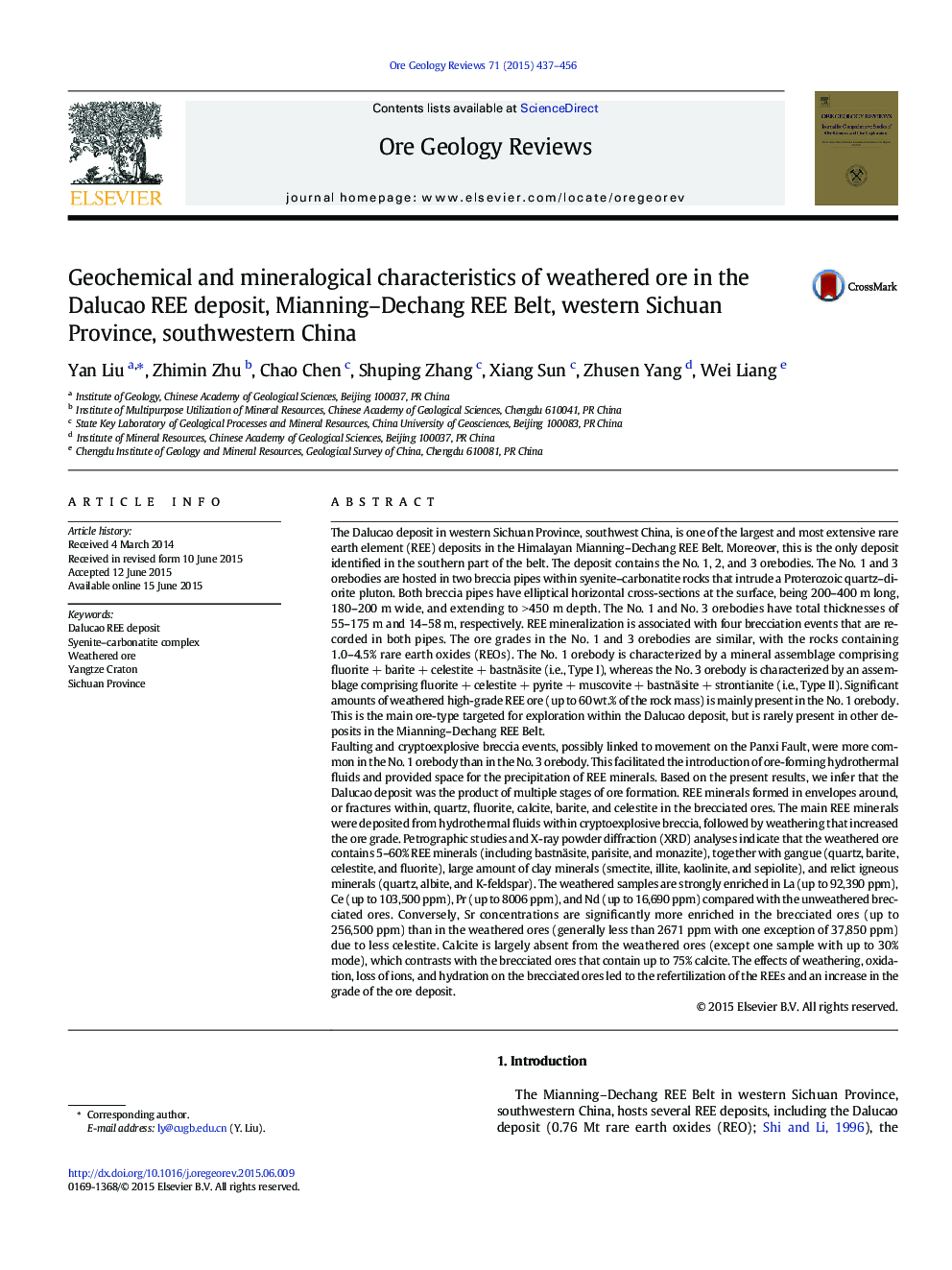| کد مقاله | کد نشریه | سال انتشار | مقاله انگلیسی | نسخه تمام متن |
|---|---|---|---|---|
| 4697027 | 1637233 | 2015 | 20 صفحه PDF | دانلود رایگان |

• Weather ores are highly enriched in REE mineral (up to 60 wt.%).
• Weather ores has higher content of La, Ce, Pr and Nd than brecciated ores.
• Large amount of clay minerals formed during weathering.
• Oxidation, loss of ions, and hydration on brecciated ores lead to weathered ore.
The Dalucao deposit in western Sichuan Province, southwest China, is one of the largest and most extensive rare earth element (REE) deposits in the Himalayan Mianning–Dechang REE Belt. Moreover, this is the only deposit identified in the southern part of the belt. The deposit contains the No. 1, 2, and 3 orebodies. The No. 1 and 3 orebodies are hosted in two breccia pipes within syenite–carbonatite rocks that intrude a Proterozoic quartz–diorite pluton. Both breccia pipes have elliptical horizontal cross-sections at the surface, being 200–400 m long, 180–200 m wide, and extending to > 450 m depth. The No. 1 and No. 3 orebodies have total thicknesses of 55–175 m and 14–58 m, respectively. REE mineralization is associated with four brecciation events that are recorded in both pipes. The ore grades in the No. 1 and 3 orebodies are similar, with the rocks containing 1.0–4.5% rare earth oxides (REOs). The No. 1 orebody is characterized by a mineral assemblage comprising fluorite + barite + celestite + bastnäsite (i.e., Type I), whereas the No. 3 orebody is characterized by an assemblage comprising fluorite + celestite + pyrite + muscovite + bastnäsite + strontianite (i.e., Type II). Significant amounts of weathered high-grade REE ore (up to 60 wt.% of the rock mass) is mainly present in the No. 1 orebody. This is the main ore-type targeted for exploration within the Dalucao deposit, but is rarely present in other deposits in the Mianning–Dechang REE Belt.Faulting and cryptoexplosive breccia events, possibly linked to movement on the Panxi Fault, were more common in the No. 1 orebody than in the No. 3 orebody. This facilitated the introduction of ore-forming hydrothermal fluids and provided space for the precipitation of REE minerals. Based on the present results, we infer that the Dalucao deposit was the product of multiple stages of ore formation. REE minerals formed in envelopes around, or fractures within, quartz, fluorite, calcite, barite, and celestite in the brecciated ores. The main REE minerals were deposited from hydrothermal fluids within cryptoexplosive breccia, followed by weathering that increased the ore grade. Petrographic studies and X-ray powder diffraction (XRD) analyses indicate that the weathered ore contains 5–60% REE minerals (including bastnäsite, parisite, and monazite), together with gangue (quartz, barite, celestite, and fluorite), large amount of clay minerals (smectite, illite, kaolinite, and sepiolite), and relict igneous minerals (quartz, albite, and K-feldspar). The weathered samples are strongly enriched in La (up to 92,390 ppm), Ce (up to 103,500 ppm), Pr (up to 8006 ppm), and Nd (up to 16,690 ppm) compared with the unweathered brecciated ores. Conversely, Sr concentrations are significantly more enriched in the brecciated ores (up to 256,500 ppm) than in the weathered ores (generally less than 2671 ppm with one exception of 37,850 ppm) due to less celestite. Calcite is largely absent from the weathered ores (except one sample with up to 30% mode), which contrasts with the brecciated ores that contain up to 75% calcite. The effects of weathering, oxidation, loss of ions, and hydration on the brecciated ores led to the refertilization of the REEs and an increase in the grade of the ore deposit.
Journal: Ore Geology Reviews - Volume 71, December 2015, Pages 437–456